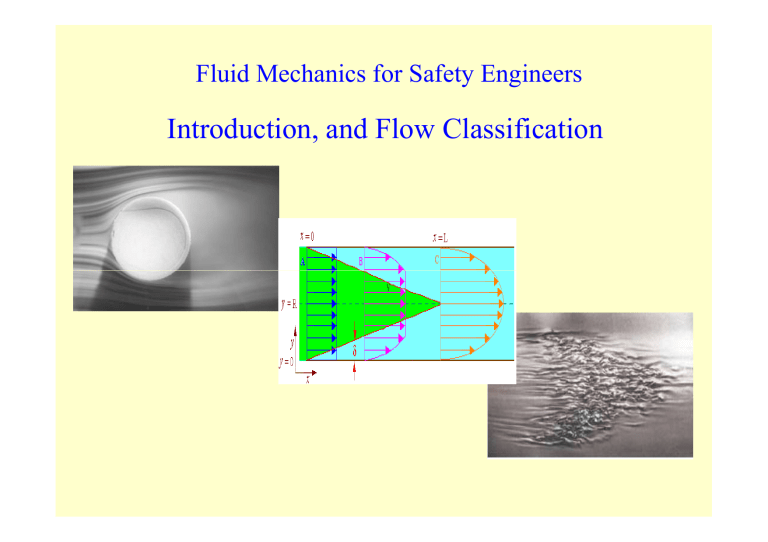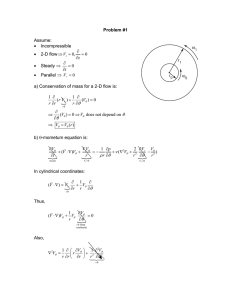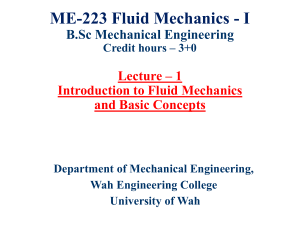
Fluid Mechanics for Safety Engineers Introduction, and Flow Classification What is a fluid? Characteristics of Fluids Classification of Flows Fluid mechanics is defined as the science that deals with the behavior of fluids (liquids and gases ) at rest (fluid statics) or in motion (fluid dynamics), and the interaction of fluids with solids or other fluids at the boundaries. It is concerned with understanding, predicting, and controlling the behavior of a fluid. Fluid mechanics categories Hydrodynamics referred for the motion of fluids that are practically incompressible (such as liquids, especially water, and gases at low speeds) a) Hydraulics, which deals with liquid flows in pipes and open channels. b) Gas dynamics deals with the flow of fluids that undergo significant density changes, such as the flow of gases through nozzles at high speeds. Aerodynamics deals with the flow of gases (especially air) over bodies such as aircraft, rockets, and automobiles at high or low speeds. Meteorology, oceanography, and hydrology deal with naturally occurring flows. Fluid Mechanics Gas Liquids Statics ∑F = 0 i Air, He, Ar, N2, etc. Water, Oils, Alcohols, etc. Stability Pressure Surface Tension Compressibility Density Fluid properties Viscosity Dynamics ∑ F > 0 , Flows Buoyancy i Compressible/ Incompressible Laminar/ Turbulent Steady/Unsteady Vapor Pressure Viscous/Inviscid Fluid Statics Fluid Dynamics Differences between solids and fluids Parallel plate shearing device γ small angle: tan (γ) = γ The shear strain is the displacement in the direction of the applied force, x, normalized by the height of the solid (perpendicular to the applied force), γ G, is the shear modulus of the solid No Slip Condition For many common liquids, and all gases µ is a fluid property known as the absolute or dynamic viscosity Newton’s law of viscosity A fluid is a substance in the gaseous or liquid form Distinction between solid and fluid: Solid: Can resist an applied shear by deforming, i.e. shear produces deformation Stress is proportional to strain. When a constant shear force is applied, a solid eventually stops deforming, at some fixed strain angle Fluid: Deforms continuously under applied shear, i.e. shear produces flow. Stress is proportional to strain rate. Never stops deforming and approaches a certain rate of strain when a constant shear force is applied. Thus, for a fluid at rest, all shear stresses must be absent. The fundamental difference lies in the response to a shear stress Shear stress and Pressure Stress is defined as the force per unit area. Normal component: of a force acting on a surface per unit area is normal stress • In a fluid at rest, the normal stress is called pressure. Tangential component of a force acting on a surface per unit area is shear stress A fluid at rest is at a state of zero shear stress because the supporting walls of a fluid eliminate shear stress. For fluids at rest, the shear stress is zero and pressure is the only normal stress. In a liquid, chunks of molecules can move relative to each other, but the volume remains relatively constant because of the strong cohesive forces between the molecules A liquid takes the shape of the container it is in and forms a free surface in the presence of gravity Gas molecules are widely spaced, and the cohesive forces between them are very small. A gas expands until it encounters the walls of the container and fills the entire available space. Gases cannot form a free surface When a weight is applied to the piston When a weight is applied to the piston solid liquid gas Intermolecular bonds are strongest in solids and weakest in gases. Molecules in solids are closely packed together, whereas in gases they are separated by relatively large distances. The molecules in a solid are arranged in a pattern that is repeated throughout. The attractive forces of molecules on each other are large and keep the molecules at fixed positions. Gas and vapor are often used as synonymous words The vapor phase called a gas when it is above the critical temperature. Vapor usually implies a gas that is not far from a state of condensation Molecules in the gas phase are at a considerably higher energy level than they are in the liquid or solid phase. The gas must release a large amount of its energy before it can condense or freeze. Any practical fluid system consists of a large number of molecules, and the properties of the system naturally depend on the behavior of these molecules. The pressure of a gas in a container is the result of momentum transfer between the molecules and the walls of the container. To determine the pressure in the container, it would be sufficient to attach a pressure gage to the container Characteristics of Fluids For liquid state “Large” molecular spacing relative to a solid “Weak” intermolecular cohesive forces Can not resist a shear stress in a stationary state Will take the shape of its container Generally considered a continuum Viscosity distinguishes different types of fluids Classification of Flows • We classify flows as a tool in making simplifying assumptions to the governing partial-differential equations, which are known as the NavierStokes equations – Conservation of Mass (Continuity equation) time derivative of the momentum surface forces on a fluid element mass forces acting on a fluid element molecular-dependent momentum input per unit time into a fluid element Conservation of Mass (Continuity equation) For incompressible fluid Continuity equation z ∆z x y ∆x ∆y Continuity equation Viscous vs. Inviscid Regions effects of Floware significant are Regions where frictional called viscous regions. They are usually close to solid surfaces. Regions where frictional forces are small compared to inertial or pressure forces are called inviscid (regions not close to solid surfaces). The friction or internal resistance to flow is quantified by the fluid property viscosity, It is a measure of internal stickiness of the fluid. Viscosity is caused by cohesive forces between the molecules in liquids and by molecular collisions in gases Viscous vs. Inviscid Regions of Flow The development of viscous and inviscid regions of flow as a result of inserting a flat plate parallel into a fluid stream of uniform velocity Internal vs. flow External Flow as being internal or external, A fluid is classified depending on whether the fluid is forced to flow in a confined channel or over a surface Internal flows are dominated by the influence of viscosity throughout the flow field Internal vs. External Flow For external flows, viscous effects are limited to the boundary layer and wake . Compressible vs. Incompressible Flow A flow is classified as being compressible or incompressible, depending on the level of variation of density during flow. A flow is classified as incompressible if the density remains nearly constant. Liquid flows are typically incompressible. Gas flows are often compressible, especially for high speeds. Compressible vs. Incompressible Flow Mach number, = 346 m/s is a good indicator of whether or not compressibility effects are important. – – – – – Ma < 0.3 : Incompressible Ma < 1 : Subsonic Ma = 1 : Sonic Ma > 1 : Supersonic Ma >> 1 : Hypersonic Laminar vs. Turbulent Flow fluid motion with smooth Laminar: highly ordered streamlines or layers (The flow of high-viscosity fluids at low velocity) Turbulent: highly disordered fluid motion occurs at high velocities characterized by velocity fluctuations and eddies. Transitional: a flow that contains both laminar and turbulent regions Laminar vs. Turbulent Flow Reynolds number, is the key parameter in determining whether or not a flow is laminar or turbulent. Laminar vs. Turbulent Flow Laminar Turbulent Steady vs. Unsteady Flow • Steady implies no change at a point with time. Transient terms in N-S equations are zero (flow in turbines, compressors, boilers, condensers, and heat Exchangers) Unsteady is the opposite of steady. Transient usually describes a starting, or developing flow. Periodic refers to a flow which oscillates about a mean. Unsteady flows may appear steady if “timeaveraged” Natural (or Unforced) versus Forced Flow Forced flow: A fluid is forced to flow over a surface or in a pipe by external means such as a pump or a fan. Natural flow: fluid motion is due to natural means such as the buoyancy effect, which manifests itself as the rise of warmer (and thus lighter) fluid and the fall of cooler (and thus denser) fluid. Natural (or Unforced) versus Forced Flow In this image, the rise of lighter, warmer air adjacent to her body indicates that humans and warm-blooded animals are surrounded by thermal plumes of rising warm air. One-, Two-, and Three-Dimensional Flows A flow field is best characterized by its velocity distribution. A flow is said to be one-, two-, or three-dimensional if the flow Flow over a car antenna velocity varies in one, two, or is approximately twodimensional except near three dimensions, respectively. the top and bottom of the antenna. However, the variation of velocity in certain directions can be small relative to the variation in other directions and can be ignored. One-, Two-, and Three-Dimensional Flows The development of the velocity profile in a circular pipe. V = V(r, z) and thus the flow is two-dimensional in the entrance region, and becomes one-dimensional downstream when the velocity profile fully develops and remains unchanged in the flow direction, V = V(r). System: quantityvolume of matter or a region in space System andAcontrol chosen for study. Surroundings: The mass or region outside the system Boundary: The real or imaginary surface that separates the system from its surroundings. The boundary of a system can be fixed or movable. Systems may be considered to be closed or open. System and system control(Control volume Closed mass): A fixed amount of mass, and no mass can cross its boundary. System and control volume Open system (control volume): A properly selected region in space. It usually encloses a device that involves mass flow such as a compressor, turbine, or nozzle. Both mass and energy can cross the boundary of a control volume. System and control volume Control surface: The boundaries of a control volume. It can be real or imaginary. An open system (a control volume) with one inlet and one exit.



